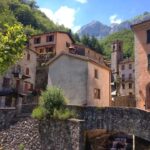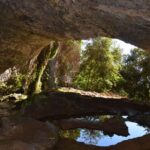Description
The etymology of the name is uncertain: the word "furnace" certainly indicates smelting activity, which has been documented since medieval times, while the word "Volasco," for some, is attributed to a certain Volasco of Brescia, who is said to have been the first to introduce the iron-excavation industry to Garfagnana. For others, the name "Volasco" comes from an ancient hospice called Volaschio.
The medieval origin of ironworking is demonstrated by interesting documents found in the archives of S. Martino di Lucca that narrate how iron mining and smelting practices were already developed in the 16th century, before the technology of the Brescians was imported. Also from some documents it appears that in 1369 the men of the village exported the iron produced as far as Stazzema.
The village lies in the Apuan Alps park in a narrow valley, at the junction of two streams, at the base of Pania della croce. The landscape is enriched by a large circular opening of a mountain named: "Monte Forato" (or Pania Forata)
It is on this mountain that "The most exciting swing in the world" is carried out! A unique experience that allows you to be able to "swing" within the arc of the perforated mountain, accompanied and followed by selected guides. The route takes about 5 hours.
The waters that divide the village into three sectors are those of the Petrosciana stream. Not far away is the majestic Wind Cave.
The flood of 1996
In the early afternoon of June 19, 1996, a sudden and devastating deluge developed over Garfagnana and Versilia, dropping a record level of rain in just a few hours.
Fornovolasco was among the towns that paid the brunt of it: a quantity of water mixed with mud and debris came down from the valley, destroying all the bridges in the town and carrying away some houses entirely.
This tragedy, however, found an immediate reaction from the population all the way to local and regional authorities, and Fornovolasco a year later was able to inaugurate the new bridges. Even the church of San Francesco D'Assisi, which had been invaded by water in the disastrous flood, was refreshed with designs by master Paolo Maiani.




